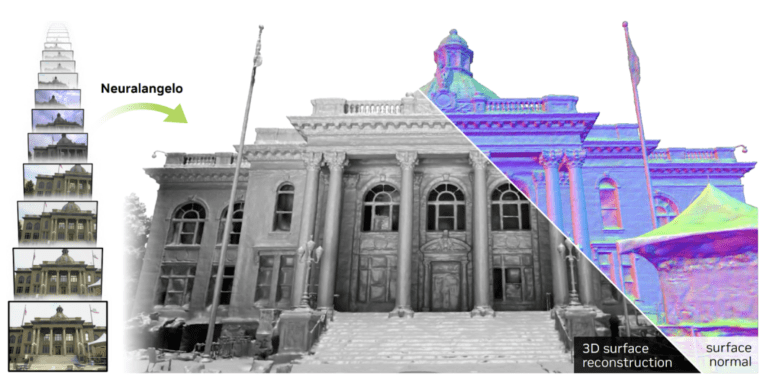TL;DR:
- Neural networks are revolutionizing 3D modeling applications, with Neural Radiance Fields (NeRFs) capturing real-world scenes using everyday cameras.
- 3D surface reconstruction aims to restore scene geometry from multiple images, offering applications in reality augmentation, virtual/mixed reality, and robotic navigation.
- Neural surface reconstruction addresses the limitations of classical methods, leveraging multi-layer perceptrons (MLPs) to represent scenes.
- Introducing Neuralangelo, a paradigm-shifting framework combining Instant NGP and neural SDF representation for high-fidelity surface reconstruction.
- Instant NGP employs hybrid 3D grids and lightweight MLPs, enhancing expressiveness while maintaining efficiency.
- Neuralangelo refines hash-encoded reconstruction with numerical gradients, stabilizing optimization, and a progressive approach to recover diverse structural levels.
- Multi-resolution hash encoding combined with neural SDF representations amplifies reconstruction capabilities.
- Extensive experimentation showcases Neuralangelo’s superiority in precision and synthesized view quality compared to image-based methods.
Main AI News:
In recent years, the strides made by neural networks have propelled them into a ubiquitous role across diverse applications. Among the most intriguing applications is the domain of three-dimensional modeling, where neural networks have shown remarkable promise. Notably, the emergence of Neural Radiance Fields (NeRFs) has revolutionized our ability to faithfully represent the intricate geometry of real-world scenes using conventional cameras. This evolution has unfurled an entirely new chapter in the saga of 3D surface reconstruction.
The paramount objective of 3D surface reconstruction is to resurrect intricate geometric compositions of a scene through the analysis of a multitude of images, each captured from distinctive vantage points. These reconstructions yield invaluable structural insights, with far-reaching applications encompassing the generation of three-dimensional assets for augmented, virtual, and mixed reality domains, as well as charting terrains for self-navigating autonomous robots. A particularly captivating avenue is the approach of photogrammetric surface reconstruction utilizing a solitary RGB camera, as this methodology empowers users to effortlessly transmute everyday mobile devices into tools for crafting digital facsimiles of the tangible world.
Crucial to the endeavor of generating rich geometric blueprints from multiple images, 3D surface reconstruction empowers an extensive array of applications, including augmented, virtual, and mixed reality realms, as well as the field of robotics. While conventional methodologies like multi-view stereo algorithms have held sway over sparse 3D reconstruction, they often grapple with ambiguities inherent in observations, yielding outcomes that fall short in accuracy or comprehensiveness. This is where neural surface reconstruction techniques have emerged as a beacon of promise. These techniques harness the prowess of coordinate-based multi-layer perceptrons (MLPs) to epitomize scenes as implicit functions. Nevertheless, the fidelity of these methods falters in tandem with the expansive potential of MLPs.
But what if the quandary of scalability was cracked wide open? What if we could bestow the capability to meticulously craft 3D surface models solely through the prism of RGB inputs? Enter Neuralangelo, the harbinger of transformative change.
Neuralangelo stands as an architectural marvel, an amalgamation of the might of Instant NGP (Neural Graphics Primitives) and the neural Signed Distance Function (SDF) representation, resulting in an unparalleled fidelity in surface reconstruction.
Harnessing the potency of Instant NGP, Neuralangelo adopts it as the bedrock for neural SDF representation of the underlying 3D tableau. Instant NGP introduces an innovative tryst of a hybrid 3D grid structure paired with a multi-resolution hash encoding, complemented by a lightweight MLP that augments expressiveness while preserving a log-linear memory footprint. This synergy of representation radically amplifies the capacity of neural fields, excelling in encapsulating intricate nuances.
In its unwavering pursuit of enhancing the caliber of hash-encoded surface reconstruction, Neuralangelo introduces two pivotal techniques. Foremost, numerical gradients come into play to compute higher-order derivatives, such as surface normals, infusing stability into the optimization trajectory. Secondly, a progressive optimization regimen is instated, unfurling structures across varying tiers of detail, thus engendering a holistic approach to reconstruction. These techniques forge an intricate alliance, ushering forth remarkable enhancements in both the precision of reconstruction and the quality of synthesized views.
Neuralangelo organically weaves the might of multi-resolution hash encoding into neural SDF representations, ushering in an era of enhanced reconstruction prowess. Furthermore, the strategic application of numerical gradients and eikonal regularization lends a veneer of refinement to hash-encoded surface reconstruction, culminating in the fortification of the optimization endeavor. Extensive experimentation across established benchmarks and real-world landscapes unfailingly underscores the potency of Neuralangelo. It takes center stage, showcasing a paradigm shift from its image-based predecessors in neural surface reconstruction, underscored by exponential strides in reconstruction precision and synthesized view excellence.

Overview of Neuralangelo. Source: Marktechpost Media Inc.
Conclusion:
The advent of Neuralangelo marks a monumental leap in 3D surface reconstruction. Its amalgamation of cutting-edge techniques not only overcomes existing limitations but also offers unprecedented accuracy and quality, reshaping the landscape of augmented reality, virtual environments, and robotics. Industries catering to these domains should closely monitor and integrate this innovation to maintain a competitive edge and deliver enriched user experiences.

